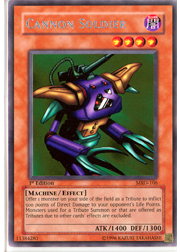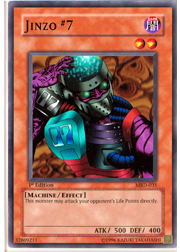

|
Doomkaiser Dragon
Card# CSOC-EN043


Doomkaiser Dragon's effect isn't just for Zombie World duelists: remember that its effect can swipe copies of Plaguespreader Zombie, too!
Click here for more
|
|
|

|
|
|

|
|
 |
 |
|
|
| |
Whenever someone asks me what was the most difficult deck to play during the first year of the game, the answer is always the same—Burn. In fact, Burn was the single most difficult deck to run successfully until the Forbidden list came into effect. To see why this was the case, let’s take a look at an example of a Burn deck from the Pharaoh’s Servant era.
Pharaoh’s Servant Typical Burn Deck
 Monsters: 18 Monsters: 18
3 Wall of Illusion
2 Princess of Tsurugi
3 Jinzo #7
2 Magician of Faith
2 Mask of Darkness
2 Sangan
2 Morphing Jar #2
2 Cannon Soldier
Spells: 16
1 Pot of Greed
1 Monster Reborn
1 Raigeki
1 Dark Hole
1 Change of Heart
1 Swords of Revealing Light
1 Card Destruction
3 Ookazi
3 Tremendous Fire
3 Messenger of Peace
Traps: 6
3 Gravity Bind
1 Mirror Force
2 Minor Goblin Official
The general strategy of this deck was to lock the opponent down with Messenger of Peace and/or Gravity Bind, and then peck him or her to death with Jinzo #7 and whatever burn spells you could muster. Once you got an opponent down to 3000 life points, Minor Goblin Official would come online, and your victory was supposedly assured. Sounds easy, right? Wrong. While the idea behind Burn decks was solid, the environment in which Burn decks existed was extremely hostile. Jinzo had just been released, and Gravity Bind caused the popularity of the Clown Control deck to rise. The combination of these factors led to Jinzo popping up in the deck of every player who owned a copy, along with two copies of Heavy Storm and one or two copies of Mystical Space Typhoon.
The Burn deck had inadvertently stepped into the middle of a brief struggle between Beatdown and Control decks. Normally, this would have been okay, because the struggle should have diversified the metagame. However, as I’ll explain a bit later, Burn decks were relatively weak compared to both Beatdown and Control decks, which made Burn a less than ideal choice for a local tournament. Nevertheless, there were many brave souls who tried, and tried, and tried some more to make Burn decks work. Some players used equip spells like Axe of Despair to make Jinzo #7 kill opponents more quickly. Unfortunately, those players found out that the Axe didn’t mix well with the all-around nice guy called Messenger of Peace.
Other players tried to combine equip spells with Catapult Turtle to cause greater amounts of damage. Some decks ran nothing but direct-attack monsters from Metal Raiders, and still others played monster-heavy decks to deal as much damage as possible with Cannon Soldier. Regardless of the methods used, Burn decks always ran into one major problem that had nothing to do with the opposition—Burn players would blow through their hands in two turns at the most.
Burn decks have never been good for players who like to maintain a healthy hand count at all times. To continue dealing damage, the Burn player must constantly play his or her cards. Meanwhile, a Beatdown player only needs to play one or two cards every turn in order to maintain an advantage. The Burn player’s classic opening move is to set his or her entire hand and say “go.” This kind of hand disadvantage isn’t just a problem with classic Burn decks, either—even the most advanced and up-to-date Burn decks can stall out from lack of cards.
 What happened when the Burn deck ran out of cards to play? It sat there and did nothing. Maybe it singed an opponent for 500 damage with Jinzo #7, but for the most part, the deck was dead in the water and waiting for Heavy Storm to put it out of its misery. Nowadays, sitting around isn’t as huge of a drawback, because cards like Wave-Motion Cannon need some downtime in order to work. But back then, doing nothing was almost sure-fire death. Almost. What happened when the Burn deck ran out of cards to play? It sat there and did nothing. Maybe it singed an opponent for 500 damage with Jinzo #7, but for the most part, the deck was dead in the water and waiting for Heavy Storm to put it out of its misery. Nowadays, sitting around isn’t as huge of a drawback, because cards like Wave-Motion Cannon need some downtime in order to work. But back then, doing nothing was almost sure-fire death. Almost.
Let’s take a look at the matchups to see what advantages Burn had, if any.
Against Beatdown
This match went to Beatdown nearly 80 percent of the time. With the ability to search for Jinzo and frequently recycle key removal spells like Nobleman of Crossout and Raigeki, Beatdown had all the tools it needed to thwart Burn at every turn. The only thing that Burn could really hope for in this matchup was to get a hand full of stall spells and Jinzo #7. Otherwise, the Burn player would be reduced to sitting around and waiting for the end almost from the first turn of the game.
Against Burn
Obviously, Burn has had to win against itself. As was the case in most mirror matches, game 1 was almost entirely decided by luck. Games 2 and 3 were all about the side decks. Most Burn players side decked some equip spells and Beatdown-oriented cards like Nobleman of Crossout. Burn players also tended to have Hayabusa Knight or some direct-attack monsters that could exploit the weaknesses of Messenger of Peace and Gravity Bind. Many Burn players flat-out removed their stall cards in games 2 and 3 of the mirror match, which was an excellent move in matches where you needed only one copy of a specific card in play for that card’s purpose to be served.
Against Control
This matchup usually went in favor of Control. Once the Control player got out two copies of Dream Clown, and the Clowns were alternating between attacking and using their effect, it became difficult for Burn to work. Burn’s only trump cards in this matchup were its two copies of Princess of Tsurugi. Control decks frequently ran many of the same stall cards as Burn decks, so the Princess could get a big hit in against a Control player who had carelessly used a bunch of spells or traps. However, any chance that Burn may have had due to the element of surprise was totally eliminated in games 2 and 3. Control players could bring in their own copies of Princess of Tsurugi and attack monsters directly, making Burn players deal with a deadly combination of attacking and burning power. This matchup wasn’t a pretty sight!
Against Exodia
Victory for Burn! Exodia players didn’t want to attack, but did want to set a lot of spells and traps. Exodia had no way to stop Burn from doing its thing. Direct attackers were key cards in all games of this matchup. In games 2 and 3, Burn could rotate in some hand-disruption cards to make an Exodia player’s life more miserable than it already was. Exodia players could either switch into Beatdown cards, switch into Control cards, or cry. If an Exodia deck was only set up to do the first or last options, Burn was a sure pick to win. If the Exodia player side decked into Control, the match was more difficult for Burn to win. However, most Exodia decks were forced to stick with the third option.
Overall, Burn was definitely a sub-standard deck to play in the era of Pharaoh’s Servant, and the deck remained that way until it was given a booster shot in the form of Ancient Sanctuary’s Level Limit - Area B. Burn has certainly come a long way since then, and the deck is now capable of holding its own against the “big boys.” Burn has made it to the Top 8 of Regional tournaments, and some Burn players have even qualified for Nationals. How things have changed . . .
Speaking of change, I have an important announcement, especially for those of you who keep coming back week after week to read this column. This week will be the last installment of Historical Perspectives for a while. That doesn’t mean that I’ll be going away any time soon. On the contrary, I’ll be writing a new column starting next week that I’m sure you’ll enjoy or at least find to be helpful. Until next time, remember that history doesn’t make itself—someone has to make it happen. Get out there and make your mark on the world!
Next week: It’s time to throw down the gauntlet!
Questions? Comments? Suggestions?
jcmchale@andrew.cmu.edu |
| |
| Top of Page |
|
 |
| |
 |